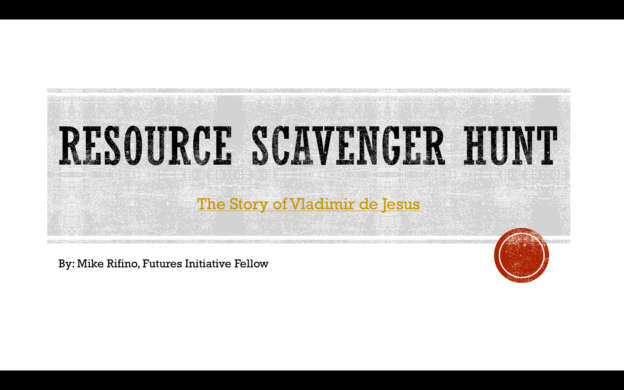August 9th was an exciting day for my Futures Initiative team!
This was the day that after a competitive application process, we would finally meet our new (and some recurring) twenty-five undergraduate leadership fellows! On August 9th, we invited these fellows to a introductory workshop at The Graduate Center, CUNY. For this day, we had an exciting line up of student-centered and collaborative activities all with the aim of establishing a sense of community among ourselves and our fellow leaders.
The activity that I facilitated was a Resource Scavenger Hunt. In what follows, I outline my lesson plan and I reconstruct how the leaders reacted and engaged to this activity. I conclude with some insights that arose during this activity and I also mention what I could have done differently. Hopefully, you will find use in this activity to try it in your own classroom.
This scavenger hunt activity is based off a video clip about Vladimir de Jesus, a LaGuardia Community College student struggling with remedial math course.

The rationale:
1) for leaders to get to know and collaborate with their peers
2) for leaders to gain a deeper understanding of their college resources
3) for leaders to practice solidarity and peer advising: help leaders reflect on how they would relate to Vladimir in advising him.
Outline of my lesson plan:
1) Prior to this workshop, Leaders were notified to bring in a laptop or smart device that could
access the internet.
2) Before the video clip was shown, Leaders were put into groups based on their respective CUNY campus college. For instance, all Baruch college Leaders gathered into one table, all Hunter college students gathered into one table, etc. Some groups were uneven because we didn’t have an equal count of leaders from each CUNY campus.
3) Together, we watched the video clip to the New York Times’ article, “Community College Students Face a Very Long Road to Graduation”. This article focuses on Vladimir de Jesus, a LaGuardia Community College student, who dreams of becoming an art teacher is struggling toward completing his degree.

4) After the video, Leaders in their respective CUNY college groups, were given two prompts to reflect on and discuss with their peers: 1) How would you classify Vladimir’s main struggle? 2) Based on that description, what resources (whether it be academic, student affairs related, etc.) from your college would you offer Vladimir? Next, Leaders together in their groups searched their college website for resources that they believed will aid Vladimir’s journey through college. Leaders were given approximately fifteen minutes to work in groups.
5) We came back together as a group and Leaders shared what they found.
The outcome
As leaders shared their insights with the entire group, I immediately noticed that there was a pattern in what the fellows chose to share to the whole group. Most of the responses focused on addressing the second prompt (i.e., what resources from your college would you offer Vladimir). Although this was a good learning experience for them (I heard some Leaders say “I never knew this resource existed”), I was curious about their impressions of Vladimir and specifically, how do they relate to his story? Do they see themselves in his shoes? Do they empathize with him or do they dismiss his struggles as trivial? Does Vladimir sheds light on concerns and obstacles they face in college? Does Vladimir’s case articulate an experince in college they felt, but were not aware of?

I made an interjection to encourage the leaders to redirect their focus to the socio-emotional dimension of mentoring- What would you do if Vladimir were to come into your office? How would you offer advice? Would you focus on his struggles (math) or his strengths (art)? Are his struggles in math really Vladimir’s own limitation or are they stemming from poor educational practices (bad curriculum, pedagogy, etc.) Of course, like all cases, Vladimir’s case is dyanmic, multifaceted, and cannot be reduced to a strict binary of either blaming him or education. My intention for this, was for the students to begin seeing the complexity of the student experince and how challegning it can be to help people. This allowed other leaders to jump in to discuss how they would encourage him to talk through the challenges he encountered.
Conclusion
Overall, I thought this was a successful activity that allowed the leaders to get to know each other, their CUNY campus, and to have a space to discuss common issues in higher education. One point I wish I emphasized more was what to do with the list of resources each group complied. At the end of the activity, I mentioned that it would be useful to compile their list and share it on our blog site. To make this process smoother, if I were to do this activity again, I would empathize each group to create a shared Google Doc for themselves so that all leaders can edit and input links and thoughts into. That way, at the end, compiling and upload their list of resources could be much easier.
List of resources
The New York Times article: Community College Students Face a Very Long Road to Graduation
Megan Boler’s Feeling Power: Emotions and Education (focus on preface and chapter six). As I wrote this reflection, I was reminded of reading Boler’s amazing book on emotions and education. I think focusing on chapter six where she distinguishes between passive empathy and testimonial reading are great concepts you can share with students as they reflect on Vladimir and talk about his struggles and relate it to theirs.
Futures Initiative Undergraduate Leader Institute Working Agenda
This is the agenda for our workshop where this activity took place. For more student-centered activities, please check out this agenda!
